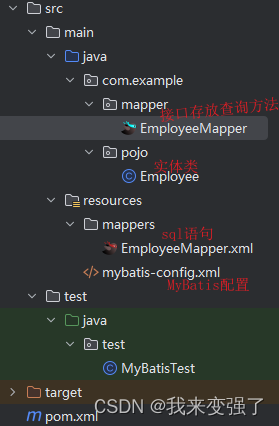MyBatis首页![]() https://mybatis.net.cn/
https://mybatis.net.cn/
1.项目目录

2.数据库
CREATE DATABASE `mybatis-example`;
USE `mybatis-example`;
CREATE TABLE `t_emp`(
emp_id INT AUTO_INCREMENT,
emp_name CHAR(100),
emp_salary DOUBLE(10,5),
PRIMARY KEY(emp_id)
);
INSERT INTO `t_emp`(emp_name,emp_salary) VALUES("lamu",200.33);
INSERT INTO `t_emp`(emp_name,emp_salary) VALUES("leimu",666.66);
INSERT INTO `t_emp`(emp_name,emp_salary) VALUES("486",777.77);3.依赖导入pom.xml
<dependencies>
<!-- mybatis依赖 -->
<dependency>
<groupId>org.mybatis</groupId>
<artifactId>mybatis</artifactId>
<version>3.5.11</version>
</dependency>
<!-- MySQL驱动 mybatis底层依赖jdbc驱动实现,不需要导入连接池,mybatis自带! -->
<dependency>
<groupId>mysql</groupId>
<artifactId>mysql-connector-java</artifactId>
<version>8.0.25</version>
</dependency>
<!--junit5测试-->
<dependency>
<groupId>org.junit.jupiter</groupId>
<artifactId>junit-jupiter-api</artifactId>
<version>5.3.1</version>
</dependency>
<dependency>
<groupId>org.projectlombok</groupId>
<artifactId>lombok</artifactId>
<version>1.18.28</version>
<scope>provided</scope>
</dependency>
</dependencies>4.实体类
@Data
public class Employee {
private Integer empId;
private String empName;
private Double empSalary;
@Override
public String toString() {
return "Employee{" +
"empId=" + empId +
", empName='" + empName + '\'' +
", empSalary=" + empSalary +
'}';
}
}5.定义mapper接口
public interface EmployeeMapper {
Employee queryById(Integer id);
//int返回值用于接受受影响的行数
int insertEmployee(Employee employee);
//根据工资查询员工信息
List<Employee> queryBySalary(Double salary);
//根据员工姓名和工资查询员工信息
List<Employee> queryByNameAndSalary(@Param("param1") String name, @Param("param2") Double salary);
//插入员工数据,传入的是一个map(name=员工的名字,salary=员工的薪水)
//mapper接口中不允许重载!!! 方法名重复了 id名重复了!
int insertEmpMap(Map data);
//员工插入
int insertEmp(Employee employee);
}6.准备MyBatis配置文件
<?xml version="1.0" encoding="UTF-8" ?>
<!DOCTYPE configuration
PUBLIC "-//mybatis.org//DTD Config 3.0//EN"
"http://mybatis.org/dtd/mybatis-3-config.dtd">
<configuration>
<settings>
<!-- 开启了 mybatis的日志输出,选择使用system进行控制台输出-->
<setting name="logImpl" value="STDOUT_LOGGING"/>
<!--开启驼峰式自动映射 数据库 a_column->java aColumn -->
<setting name="mapUnderscoreToCamelCase" value="true"/>
</settings>
<!-- 定义自己类的别名 -->
<typeAliases>
<!-- 单独定义 -->
<!-- <typeAlias type="com.example.pojo.Employee" alias="hahaha" />-->
<!-- 批量将包下的类给与别名,别名就是类的首字母小写! -->
<package name="com.example.pojo"/>
</typeAliases>
<!-- environments表示配置Mybatis的开发环境,可以配置多个环境,在众多具体环境中,使用default属性指定实际运行时使用的环境。default属性的取值是environment标签的id属性的值。 -->
<environments default="development">
<!-- environment表示配置Mybatis的一个具体的环境 -->
<environment id="development">
<!-- Mybatis的内置的事务管理器
MANAGED 不会自动开启事务! | JDBC 自动开启事务 , 需要自己提交事务!
-->
<transactionManager type="JDBC"/>
<!-- 配置数据源
type=POOLED mybatis帮助我们维护一个链接池 | UNPOOLED 每次都新建或者释放链接
-->
<dataSource type="POOLED">
<!-- 建立数据库连接的具体信息 -->
<property name="driver" value="com.mysql.cj.jdbc.Driver"/>
<property name="url" value="jdbc:mysql://localhost:3306/mybatis-example"/>
<property name="username" value="root"/>
<property name="password" value="123456"/>
</dataSource>
</environment>
</environments>
<mappers>
<!-- Mapper注册:指定Mybatis映射文件的具体位置 -->
<!-- mapper标签:配置一个具体的Mapper映射文件 -->
<!-- resource属性:指定Mapper映射文件的实际存储位置,这里需要使用一个以类路径根目录为基准的相对路径 -->
<!-- 对Maven工程的目录结构来说,resources目录下的内容会直接放入类路径,所以这里我们可以以resources目录为基准 -->
<mapper resource="mappers/EmployeeMapper.xml"/>
</mappers>
</configuration>7.定义mapper xml
- 方法名和SQL的id一致
- 方法返回值和resultType一致
- 方法的参数和SQL的参数一致
<?xml version="1.0" encoding="UTF-8" ?>
<!DOCTYPE mapper
PUBLIC "-//mybatis.org//DTD Mapper 3.0//EN"
"https://mybatis.org/dtd/mybatis-3-mapper.dtd">
<!-- namespace = mapper对应接口的全限定符 -->
<mapper namespace="com.example.mapper.EmployeeMapper">
<select id="queryById" resultType="com.example.pojo.Employee">
select emp_id empId , emp_name empName , emp_salary empSalary
from t_emp where emp_id = ${id}
</select>
<insert id="insertEmployee">
insert into t_emp(emp_name,emp_salary) values(#{empName},#{empSalary})
</insert>
<!--zai配置中typeAliases标签声明批量将包下的类给与别名,别名就是类的首字母小写-->
<select id="queryBySalary" resultType="Employee">
select emp_id empId , emp_name empName , emp_salary empSalary
from t_emp where emp_salary = #{ salary }
</select>
<!--
场景3: 传入多个简单类型数据如何取值 key!
可以不可以随便写? 不可以!
按照形参名称获取? 也不可以!
方案1: 注解指定 @Param注解 指定多个简单参数的key key = @Param("value值") [推荐]
方案2: mybatis默认机制
argo arg1 .... 形参左到右依次对应 argo arg1..
(name,salary) name-> key = arg0 salary -> key = arg1
param1 param2 ....
(name,salary) name-> key = param1 salary -> key = param2
-->
<select id="queryByNameAndSalary" resultType="Employee">
select emp_id empId , emp_name empName , emp_salary empSalary
from t_emp where emp_name = #{param1} and emp_salary = #{param2}
</select>
<!-- <select id="queryByNameAndSalary" resultType="com.example.pojo.Employee">-->
<!-- select emp_id empId , emp_name empName , emp_salary empSalary-->
<!-- from t_emp where emp_name = #{arg0} and emp_salary = #{arg1}-->
<!-- </select>-->
<!-- 场景4: 传入map 如何指定key的值
key = map的key即可!
-->
<insert id="insertEmpMap">
insert into t_emp (emp_name , emp_salary ) values (#{name},#{salary});
</insert>
<!--输出:
场景1: 返回单个简单类型如何指定 resultType的写法! 返回值的数据类型!!
resultType语法:
1.类的全限定符号
2.别名简称
mybatis给我们提供了72种默认的别名!
这些都是我们常用的Java数据类型! [java的常用数据类型]
基本数据类型 int double -> _int _double
包装数据类型 Integer Double -> int integer double
集合容器类型 Map List HashMap -> 小写即可 map list hashmap
扩展:如果没有没有提供的需要自己定义或者写类的全限定符号
给自己声明的类如何定义别名:
mybatis-config.xml
给类单独定义别名!!!
<typeAliases>
<typeAlias type="com.example.pojo.Employee" alias="hahaha" />
</typeAliases>
批量设置:
<typeAliases>
批量将包下的类给与别名,别名就是类的首字母小写!
<package name="com.example.pojo"/>
</typeAliases>
扩展,如果不想使用批量的别名,可以使用注解给与名字!
@Alias("hahaha")
-->
<select id="queryNameById" resultType="string">
select emp_name from t_emp where emp_id = #{id}
</select>
<select id="querySalaryById" resultType="_double">
select emp_salary from t_emp where emp_id = #{id}
</select>
<!--
场景2: 返回单个自定义类类型
//返回单个自定义实体类型
Employee queryById(Integer id);
resultType : 返回值类型即可
默认要求:
查询,返回单个实体类型,要求列名和属性名要一致!
这样才可以进行实体类的属性映射!
但是可以进行设置,设置支持驼峰式自动映射!
emp_id -> empId === empId
mybatis-config.xml
<setting name="mapUnderscoreToCamelCase" value="true"/>
-->
<select id="queryById1" resultType="employee" >
select *
from t_emp where emp_id = ${id}
</select>
<!-- 场景3: 返回map
当没有实体类可以使用接值的时候!
我们可以使用map接受数据!
key - > 查询的列
value -> 查询的值
-->
<select id="selectEmpNameAndMaxSalary" resultType="map">
SELECT
emp_name 员工姓名,
emp_salary 员工工资,
(SELECT AVG(emp_salary) FROM t_emp) 部门平均工资
FROM t_emp WHERE emp_salary=(
SELECT MAX(emp_salary) FROM t_emp
)
</select>
<!--
场景4: 返回的是集合类型如何指定
//查询工资高于传入值的员工姓名们 200
List<String> queryNamesBySalary(Double salary);
//查询全部员工信息
List<Employee> queryAll();
Employee queryById();
切记: 返回值是集合。resultType不需要指定集合类型,只需要指定泛型即可!!
为什么?
mybatis -> ibatis -> selectOne 单个 | selectList 集合 -> selectOne中 调用 [ selectList ]
-->
<select id="queryNamesBySalary" resultType="string">
select emp_name from t_emp where emp_salary > #{ salary }
</select>
<select id="queryAll" resultType="employee">
select * from t_emp
</select>
<!--
场景5: 主键回显 获取插入数据的主键
1. 自增长主键回显 mysql auto_increment
//员工插入
int insertEmp(Employee employee);
useGeneratedKeys="true" 我们想要数据库自动增强的主键值
keyColumn="emp_id" 主键列的值!!!
keyProperty="empId" 接收主键列值的属性!!!
-->
<insert id="insertEmp" useGeneratedKeys="true" keyColumn="emp_id" keyProperty="empId">
insert into t_emp (emp_name,emp_salary)
value(#{empName},#{empSalary});
</insert>
<!--
期望,非自增长的主键,交给mybatis帮助我们维护!
-->
<insert id="insertxxx">
<!-- 插入之前,先指定一段sql语句,生成一个主键值!
order="before|after" sql语句是在插入语句之前还是之后执行!
resultType = 返回值类型
keyProperty = 查询结果给哪个属性赋值
//自己维护主键
String id = UUID.randomUUID().toString().replaceAll("-", "")
teacher.settId(id);
-->
<selectKey order="BEFORE" resultType="string" keyProperty="tId">
SELECT REPLACE(UUID(),'-','');
</selectKey>
INSERT INTO teacher (t_id,t_name)
VALUE(#{tId},#{tName});
</insert>
<!--
Teacher queryById(String tId);
列名和属性不一致如何解决:
方案1: 别名 select t_id tId , t_name tName from teacher where t_id = #{tId}
方案2: 开启驼峰式映射 <setting name="mapUnderscoreToCamelCase" value="true"/>
t_id tId 自动映射
方案3: resultMap自定义映射 (resultType和resultMap二选一)
resultType按照规则自动映射 按照是否开启驼峰式映射,自己映射属性和列名! 只能映射一层结构!
深层次的对象结构无法映射,多表查询的时候结果无法映射!
Order - 数据库
orderId order_id
orderName order_name
OrderItem orderItem
item_id item_id
resultMap标签,自定义映射关系,可以深层次可以单层次!!!
-->
<!-- 声明resultMap标签,自己定义映射规则
id标识 -> select resultMap="标识"
type -> 具体的返回值类型 全限定符和别名 | 集合只写泛型即可
<id 主键映射关系
<result 普通列的映射关系
-->
<resultMap id="tMap" type="employee">
<id column="emp_id" property="empId" />
<result column="emp_name" property="empName"/>
</resultMap>
<select id="queryById2" resultMap="tMap">
select * from teacher where t_id = #{tId}
<!--select t_id tId , t_name tName from teacher where t_id = #{tId}-->
</select>
</mapper>8.测试
public class MyBatisTest {
@Test
public void test() throws IOException {
//读取外部配置文件
InputStream ips = Resources.getResourceAsStream("mybatis-config.xml");
SqlSessionFactory sf = new SqlSessionFactoryBuilder().build(ips);
//openSession自动开启事务,不会自动提交 !
//openSession(true)自动开启事务,自动提交事务! 不需要sqlSession.commit();
SqlSession session = sf.openSession(true);
EmployeeMapper mapper = session.getMapper(EmployeeMapper.class);
Employee employee = new Employee();
employee.setEmpSalary(8888.0);
employee.setEmpName("艾米莉亚");
System.out.println(employee.getEmpId());
System.out.println("----------------------");
int rows = mapper.insertEmp(employee);
System.out.println("rows = " + rows);
System.out.println(employee.getEmpId());
session.close();
}
}




















 2061
2061











 被折叠的 条评论
为什么被折叠?
被折叠的 条评论
为什么被折叠?








